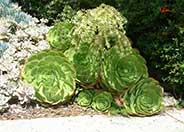
Common name:Tajiniste Tower of Jewels
Botanical name:Echium gentianoides 'Tajinaste'
We are thrilled to offer this extremely rare and endangered Echium from the island of La Palma in the Canary Islands! True cerulean blue flowers held in loose pyramidal spikes bloom the first year and are a sight to behold in the Spring garden! Emerging from pink buds, the cup-shaped flowers are well displayed above rough, blue-grey, linear foliage. EASY and impressive, it blooms Spring thru Fall, totally unlike any other Echium we know! Sturdy, branching, 4’ x 4’ form. Highly recommended! Drought, heat and deer resistant! Needs awesome drainage for ultimate happiness. Side dress with an 1” of compost once a year. Does best in full sun. Established plants need low water.

Common name:Parasol Aeonium
Botanical name:Aeonium arboreum
An upright succulent with rosette leaf clusters. Forms a mound and can be easily propagated by cuttings.

Common name:Saucer Plant
Botanical name:Aeonium urbicum
Aeonium urbicum is a large plant that can reach six feet in height. Its most distinguishing feature as a decorative plant is its lush succulent leaves organized into beautiful rosettes. The edges of individual leaves are pink, further accentuating the appearance. The plant also produces white flowers every summer. Aeonium urbicum is adapted to survive in the full glare of the sun. Therefore, you should ensure it gets sufficient sunlight when planting when determining where to locate it. Due to its appetite for sunlight, it is best to plant it outside. You can also plant it in a pot inside the house, but you will have to position it where it can bask. Another reason why the plant is best suited for the outdoors is its size. If you keep it indoors, you will have to keep working on it to prevent it from reaching its full height, which can be problematic in an indoor setting. One of the key determinants of whether you will plant it indoors is temperature. It prefers relatively warm temperatures in zone 9b-11b -3.9oC (25oF). If you live outside this zone in colder places, you are better off keeping it in an indoor setting. It will survive in the house if it gets exposed to sunlight. This plant is succulent; it stores water in its leaves and therefore, doesn’t require heavy watering. The best time to water urbicum is when the soil dries out. Of course, the water will dry out faster in the summer than in winter, and you will need to water more often in dry weather. You know your soil has dried out when the first inch is completely dry. Although it doesn’t like waterlogging, this plant needs more water than other succulents in its genus. Therefore, the potting mix you plant should be different from the one you use for other succulents. You shouldn’t grow it on cacti potting soil. The potting mix drains too fast, and it may not be suitable for the plant. If you purchase commercial pottage, mix it with perlite to make it ideal for Aeonium urbicum. The urbicum’s natural environment is rocky, and it doesn’t have a lot of nutrients. Your plant is, therefore, not feed-intensive. You can feed it with a quarter-strength succulent fertilizer once per month in its growing season. Overfeeding may spoil the plant since it isn’t adapted to synthesize too much fertilizer. It is better to avoid superphosphate fertilizers as they might contain poisonous ingredients to the plant.

Common name:Avocado
Botanical name:Persea americana
This is a large tree that can grow as large as an oak. Its exotic, semi-tropical, drupe fruit is famous for making guacamole dip. Frost damages this plant.
Designer: UC Berkeley
Photographer: Vicki Anderson
Maintain a two to four inch layer of mulch on the soil surface to reduce weeds, infiltrate rain water, and reduce compaction.
Attract, or buy beneficial insects such as ladybugs and lacewings to control pest outbreaks in your garden.